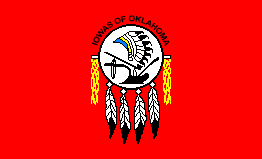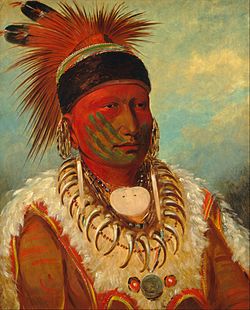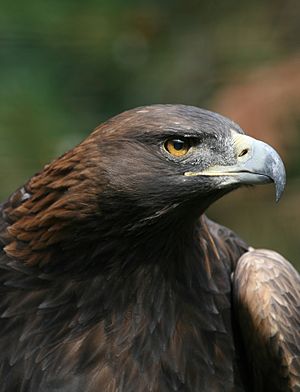Iowa Tribe of Oklahoma facts for kids

Tribal Flag
|
|

The White Cloud, Head Chief of the Iowas, painting by George Catlin
|
|
| Total population | |
|---|---|
| 800 | |
| Regions with significant populations | |
| Languages | |
| Chiwere language, English | |
| Religion | |
| traditional tribal religion, Native American Church, Christianity | |
| Related ethnic groups | |
| other Iowa peoples, Otoe, Missouria, Ho-Chunk, and other Siouan peoples |
The Iowa Tribe of Oklahoma is a Native American tribe. It is one of two groups of Iowa people officially recognized by the U.S. government. The other group is the Iowa Tribe of Kansas and Nebraska.
The Iowa people traditionally spoke the Chiwere language. This language is part of the larger Siouan language family. Their name for themselves is Bahkhoje. This means "grey snow." It comes from their old winter homes. These lodges were covered in snow that turned grey from smoke from their fires.
Every year since 1985, the tribe holds a special gathering. This event is called a powwow. It happens in mid-June. You can find it about 4 miles south of Perkins, Oklahoma, on Highway 177.
Contents
How the Tribe is Governed
The main office for the Iowa Tribe of Oklahoma is in Perkins, Oklahoma. Their tribal area covers parts of Lincoln, Logan, Oklahoma, and Payne counties in Oklahoma.
There are 800 members in the tribe. More than 490 of them live in Oklahoma. Edgar Kent is the current leader, called the tribal chairperson.
Tribal Businesses and Services
The Iowa Tribe of Oklahoma runs many programs and businesses. These help the tribe and its members.
- They issue their own special vehicle tags.
- They have a housing authority called Bah-kho-je Housing Authority.
- The tribe owns a truck stop, a gas station, and a smoke shop.
- They also operate a bingo hall, a place for off-track horse race betting, and a casino.
In 2011, the tribe's businesses added over $10 million to the economy. They run the Cimarron Casino in Perkins. The Iowa Tribe Smokeshop is in Coyle. The Ioway Casino Resort is in Chandler.
The tribe publishes a newspaper for its members. It is called the Bah-Kho-Je Journal. They also own BKH Solutions. This company offers trucking, construction, and environmental services. It also provides archaeological and energy consulting. The tribe has its own police department. They also run a child development program called Tah-Je Do-Weh Che. This includes a Head Start program for young children.
The tribe has its own art gallery. It is called the Bah-Kho-Je Gallery. It shows art by Iowa artists. These include Jean Bales, David Kaskaske, and Daniel Murray. It also features artists from related tribes. Examples are Mars Biggoose and Gina Gray. The gallery used to be in Guthrie, Oklahoma. Now it is at the Iowa tribal complex in Perkins.
Language of the Iowa People
About thirty tribal members still speak the Iowa language. This language is also known as Chiwere language. It is a Siouan language. The tribe has offered classes to teach the language. They are also giving recording devices to elders. This helps them save important language materials. These recordings can then be shared with younger generations.
History of the Iowa Tribe
The Iowa people, also called Ioway, first lived near the Great Lakes. Experts believe they were once part of a larger tribe. This larger group included the Ho-Chunk, Otoe, and Missouria tribes. In the 1500s, the Iowa, Otoe, and Missouria separated. They moved south and west.
Europeans first met the Iowa people in 1676. This happened in Green Bay, Wisconsin. At that time, the Iowa lived among the Ho-Chunk people.
Traditionally, Iowa society was split into two main groups. These were the Buffalo and Bear clans. These clans would take turns leading the tribe. They would switch every six months.
As European-Americans moved into their lands, the Iowa moved east. They settled in what is now Iowa and Missouri. But in 1839, the tribe gave up their lands. They moved to the Ioway Reservation. This reservation was on the Kansas-Nebraska border. There, disagreements arose within the tribe. Some members had mixed heritage. They wanted to adopt American ways of life. Others wanted to keep their traditional ways.
To protect their traditions, some Iowa tribal members moved. They began moving into Indian Territory in 1878. In 1883, they were given land. This land was within the Sac and Fox Reservation. Later, their shared tribal lands were divided up. This happened because of the Dawes Act. In 1890, individual plots of land were given to 109 tribal members. This was done by the Cherokee Commission.
The Curtis Act of 1898 broke up the tribal government. But the tribe was able to reorganize. They did this under the Oklahoma Indian Welfare Act of 1936. They became the Iowa Tribe of Oklahoma. They approved their own rules and constitution in 1937.
Bah Kho-Je Xla Chi: Eagle Rehabilitation Program
The tribe has a special program called Bah Kho-Je Xla Chi. It is also known as the Grey Snow Eagle House. This is a place for eagles. It was built in January 2006. It is located within the tribe's buffalo preserve.
The Grey Snow Eagle House helps injured eagles get better. It also provides a home for eagles that cannot return to the wild. The program cares for both golden eagles and bald eagles. This facility is in Perkins. It was the first place in Oklahoma that could house injured eagles. It meets the standards of the US Fish and Wildlife Service.
This eagle center is one of the few in the country open to the public. Visitors come from all over the world. This includes elders from many different Oklahoma Indian tribes. The tribe collects eagle feathers that fall out naturally. These feathers are used for religious purposes, which is allowed by law.
Victor Roubidoux, an Iowa tribal member, manages the eagle center. The tribe is currently raising money to make the center bigger. Spaces for eagles filled up very quickly. Birds from all over the United States are brought there. The tribe recently added a new flight cage. Roubidoux says, "We believe that the eagle is the only animal that has seen the face of the creator and so we honor him with respect and dignity."
Famous Iowa Tribal Members
- Jean Bales (1946–2004), a talented artist


